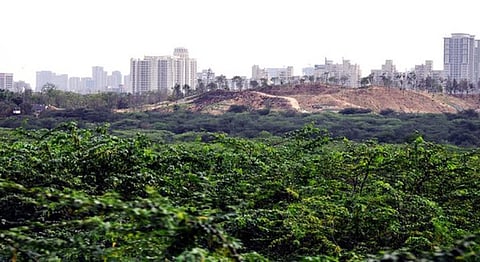
- HOMEGROWN WORLD
- #HGCREATORS
- #HGEXPLORE
- #HGVOICES
- #HGSHOP
- CAREERS
- ABOUT US
- CONTACT US

Tucked between the smoke-choked capital of Delhi and its newly renamed suburb Gurugram (formerly Gurgaon) is a lush green grove. Untouched by industrial development and deforestation, the Mangar Bani forest boasts of a thick forest cover, a variety of birds and insects, and wild fauna. And as the ever-growing urban spaces flanking this forest threaten it, the sacred grove stands protected. This unspoiled anomaly is not a product of chance, but of meticulous determination of the local villagers in the area.
The 677-acre Mangar Bani forest has been a topic of dispute in Delhi’s environmental court, the National Green Tribunal, for nearly six years. Along with these groves, the entire Aravallis needed protection from land-grabbing by builders for construction purposes. The land falls under section 4 and 5 of the Punjab Land Preservation Act of the Ministry of Environment and Forests, which bans the felling of trees without permission. Forest officials, however, find themselves helpless when the land from the protected area is being grabbed despite FIRs being lodged.
In the 1980s, affluent investors and building companies sought to buy parts of the Mangar Bani land from villagers, and piece by piece acquired large parts of it. As 28-year-old villager Sunil Harsana told
The Washington Post, “By the time people woke up and realized what was happening, much of the forest was already sold to real estate companies. Villagers blocked the takeover when they realized that the buyers actually wanted to cut trees and construct.” As real estate companies and these villagers engaged in a tedious legal battle to save the forests, activists joined as well.
Last year, Haryana Chief Minister Manohar Lal Khattar took a four-hour-long helicopter ride to survey Mangar Bani’s forestland, and personally witnessed its rich, lush cover. He concluded that he was determined to protect the groves, and stated, “The groundwater security of the entire national capital region depends upon protecting and conserving water conservation zones in this region.”
Mangar Bani has now, after an arduous legal war, been declared a no-construction zone including the 1,200-acre buffer area around the groves. Builders who have acquired forest land over the last few years are now banned from constructing on it, and the villagers living on the outskirts of the groves are celebrating their win that saved this vital green cover that replenishes the ground water of the area.
As 90-year-old resident of Mangar village Fateh Singh said, “We believe if you break even a twig in this forest for your personal need, misfortune strikes you. That fear has kept the forest alive for nearly 1,000 years.” Environmental analyst Chetan Agarwal told
The Hindu, “This is a welcome move to demarcate the Mangar Bani and its buffer on scientific principles, as a No Construction Zone, particularly the numerous flip flops of the earlier government since 2009. The time has come to notify Mangar Bani as a Sanctuary or National Park to accord permanent protection for future generations.”
